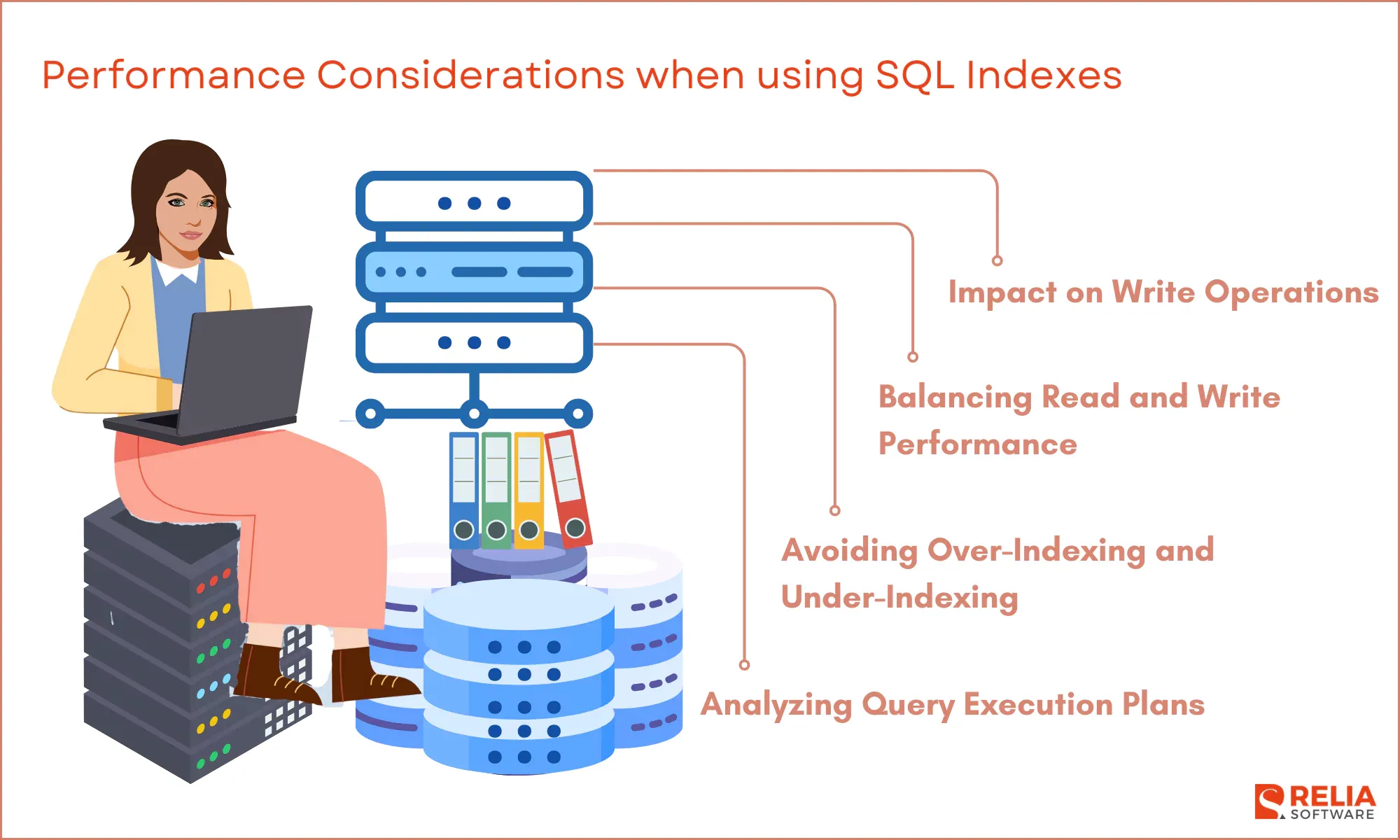SQL indexing is a database optimization technique that enhances query performance by allowing faster data retrieval. Similar to a book's index, an index in SQL provides quick lookups, reducing the need to scan entire tables. This guide covers the fundamentals, implementation, maintenance, and best practices of SQL indexing, helping both beginners and experienced developers optimize database queries and improve performance.
>> Read more:
- Database Scaling Explained: A Guide to Efficient Growth
- Vector Database vs Graph Database: Which One Is Better?
- What is a Graph Database? Benefits, Use Cases & Examples
What is An Index in SQL?
An index in SQL is a database object designed to speed up data retrieval operations on a table. Much like a book index helps you quickly find information, an SQL index helps the database locate rows without scanning the entire table.
Typically implemented as a B-tree or hash table, an index stores column values along with pointers to the corresponding rows. These pointers and indexed columns form the core components of an index. By organizing data efficiently, indexes significantly enhance query performance and overall database operations.
How Indexes Work?
Indexes enhance query performance by enabling the database to locate specific rows quickly, bypassing the need to scan the entire table. They create a data structure, often a B-tree, that organizes column values in a sorted order with pointers to the actual rows. This structure allows for fast traversals and searches, narrowing down the search range efficiently.
When a query runs, SQL uses the index to find the starting point and follows the pointers to retrieve the required data quickly. Although indexes boost read operations by minimizing data scans, they can slow down write operations (inserts, updates, deletes) since the index must be updated with each data change. Thus, balancing faster query performance with the maintenance overhead of indexes is crucial.
When to Use Indexes?
Indexes are especially useful for queries that frequently search, filter, or sort data on specific columns. They significantly enhance the performance of read-heavy operations, such as SELECT statements with WHERE clauses, JOINs, and ORDER BY clauses.
To identify slow queries that could benefit from indexing, you should look for those with long execution times or high resource usage. Use database profiling tools like SQL Server Profiler, MySQL's EXPLAIN statement, or PostgreSQL's pg_stat_activity to analyze query performance and execution plans.
By examining this data, you can pinpoint frequently accessed columns that would benefit from indexing, thereby optimizing query performance and overall database efficiency.
>> Explore further: MySQL DDL: Statements, Atomic DDL, Online DDL, Algorithms
Creating Indexes in SQL
To create indexes in SQL, use the CREATE INDEX statement to specify the table and columns to be indexed. The basic syntax is:
CREATE INDEX index_name ON table_name (column_name);For example, to index the last_name column in the customers table, you would use:
CREATE INDEX idx_last_name ON customers (last_name);You can create different types of indexes to meet various needs. For instance, a unique index ensures all values in the indexed column are unique:
CREATE UNIQUE INDEX idx_unique_email ON customers (email);A composite index optimizes queries that filter on multiple columns:
CREATE INDEX idx_full_name ON customers (first_name, last_name);Best practices for index creation include:
- Indexing columns frequently used in WHERE clauses, JOIN conditions, and ORDER BY clauses.
- Avoiding over-indexing to prevent slowing down write operations.
- Regularly monitoring and analyzing index performance, and removing those with minimal benefits.
- Considering the selectivity of indexed columns, as high uniqueness generally makes indexes more effective.
Index Maintenance
Maintaining indexes is crucial for ensuring optimal performance over time. Regularly updating indexes prevents fragmentation and maintains query efficiency. Fragmentation occurs as data is inserted, updated, and deleted, reducing performance.
Two key maintenance tasks are rebuilding and reorganizing indexes:
- Rebuilding an Index: Creates a new, defragmented copy of the index, significantly improving performance but requiring more resources and time. Example syntax in SQL Server:
ALTER INDEX index_name ON table_name REBUILD;- Reorganizing an Index: A lighter operation that defragments index pages in place with minimal system impact. Example syntax in SQL Server:
ALTER INDEX index_name ON table_name REORGANIZE;Monitoring index performance helps identify when maintenance is needed. Use profiling and monitoring tools to track index usage, fragmentation levels, and query performance. Regularly analyze query execution plans to ensure indexes are effective and adjust as necessary to optimize performance. By keeping indexes well-maintained, your database will remain efficient and responsive.
>> Read more: Unlocking Node.js Profiling to Optimize Application Performance
Common Indexing Strategies
Effective indexing strategies are crucial for optimizing database performance. Here are some common approaches:
Indexing Primary Keys and Unique Constraints
Primary keys and unique constraints are inherently indexed because they ensure the uniqueness of each row or value in a column. Indexing these columns is essential because they are frequently used in search operations and as join keys, ensuring quick retrieval and integrity of data.
Indexing Foreign Keys
Foreign keys, which establish relationships between tables, should be indexed to enhance the performance of join operations. By indexing foreign keys, you can speed up queries that involve joins between parent and child tables, ensuring efficient data retrieval and referential integrity.
Covering Indexes
A covering index includes all the columns needed by a query, allowing the database to retrieve all required data directly from the index without accessing the table itself. This can significantly improve query performance by reducing the number of I/O operations. For example, if a query frequently retrieves columns A, B, and C, creating an index on these columns can optimize the query:
CREATE INDEX idx_covering_abc ON table_name (A, B, C);Indexing for Join Operations
Joins are common in relational databases, and indexing columns used in join conditions can greatly improve performance. Indexing the columns that are frequently used in joins helps the database engine quickly locate the matching rows in each table, reducing the time needed to perform the join operation.
Indexing for Sorting and Filtering
Queries that involve sorting (ORDER BY) and filtering (WHERE) conditions benefit from indexing the relevant columns. Indexing the columns used in these operations allows the database to quickly find and sort the data, enhancing query performance. For example, if you frequently filter and sort by last_name:
CREATE INDEX idx_last_name ON customers (last_name);Implementing these indexing strategies helps ensure that your database queries run efficiently, providing faster data retrieval and improved overall performance.
Performance Considerations
Indexes are powerful tools for enhancing query performance, but they also come with trade-offs that need to be carefully managed. Here are key performance considerations when using indexes:
Impact on Write Operations
As mentioned above, while indexes speed up reads, they can slow down writes (inserts, updates, deletes) because the database must update the indexes as well. This maintenance can increase write times. Balance faster reads with the overhead of maintaining indexes.
Balancing Read and Write Performance
To achieve an optimal balance between read and write performance, carefully consider which columns to index based on the specific usage patterns of your database. In read-heavy applications, more indexes may be justified to enhance query performance.
In write-heavy applications, minimizing the number of indexes can reduce the overhead on write operations. Regularly monitoring the performance and adjusting indexing strategies as needed can help maintain this balance.
Avoiding Over-Indexing and Under-Indexing
Over-indexing occurs when too many indexes are created, leading to increased maintenance overhead and potential performance degradation during write operations. Under-indexing, on the other hand, happens when there are too few indexes, resulting in slow query performance.
The key is to identify the most critical queries and index the columns involved in those queries. Use database profiling and performance monitoring tools to determine the optimal number and types of indexes for your specific workload.
Analyzing Query Execution Plans
Query execution plans provide valuable insights into how the database engine executes queries and uses indexes. By analyzing execution plans, you can identify whether indexes are being used effectively and pinpoint any potential performance bottlenecks.
Tools like SQL Server Management Studio, MySQL's EXPLAIN, and PostgreSQL's EXPLAIN ANALYZE can help you visualize and understand the execution plans. Regularly reviewing and tuning your indexes based on these plans can ensure that your database queries remain efficient and performant.
By considering these performance aspects, you can effectively manage your indexing strategy to maximize the benefits while minimizing the drawbacks, leading to a well-optimized database system.

Conclusion
In this blog, we explored the vital role of indexing in SQL databases and its impact on query performance. We defined indexes, explained their structure, and discussed their effects on read and write operations. Key topics included when to use indexes, how to create and maintain them, and common indexing strategies. We also covered performance considerations like balancing read and write operations, avoiding over-indexing, and analyzing query execution plans.
For further reading, consider:
- "SQL Performance Explained" by Markus Winand,
- "High Performance MySQL" by Silvia Botros and Jeremy Tinley,
- "SQL Tuning" by Dan Tow.
These resources will help you continue optimizing your SQL queries and maintaining high performance in your applications.
>>> Follow and Contact Relia Software for more information!
- development
- coding

